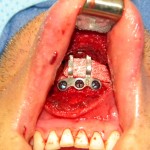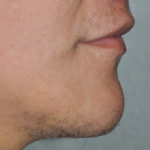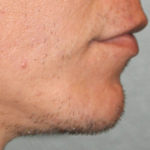When one thinks of a short or small chin, most are envisioning it deficient in the horizontal dimension. (profile view) While this does make up the majority of cases of chin augmentation, there are other dimensions in which a chin can also be ‘short’. The second most common cause of chin deficiency is in the vertical dimension or its height.
A vertically short chin is apparent in several ways. First, there is an apparent small lower face compared to the middle and upper face. As the aesthetically balanced face is divided into equal thirds, the lower third (between the lower lip and the bottom edge of the chin) will look small in height compared to the rest of the face. Second, the labiomental crease (the groove between the lower lip and chin prominence) will often be indented further in or deeper than normal. Lastly, a vertically short chin may also be associated with an underbite although not exclusively so.
Correction of the vertically short chin is primarily done by a chin osteotomy and downgrafting. Placing a chin implant further down on the chin prominence may help a little (a few millimeters) but can not make a big difference. Changing the vertical length of the chin bone addresses the actual problem and is far more effective.


While the cost and recovery from a chin osteotomy is more than from a chin implant (an extra week or so of prolonged swelling and chin stiffness), its superior results are worth this short-term sacrifice. Bringing the lower third of the face into proportionate balance can make for a very pleasing facial change in both profile and frontal views.
Dr. Barry Eppley
Indianapolis, Indiana



